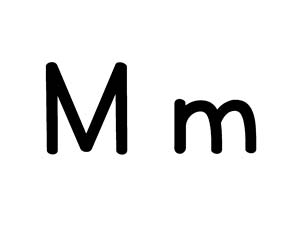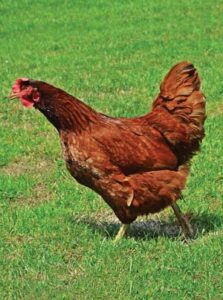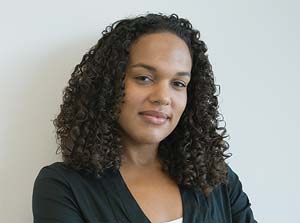Phonological awareness, Letter knowledge
Children will identify the initial sounds of familiar words. Children also will identify and name the letter M.


Review:
Be Prepared: Organize groups of three picture cards as listed below:
bat-bed-hen cat-house-cup dog-hand-hair hat-hip-pig egg-hand-elbow cow-bus-bug can-cap-sun dig-apple-dot ham-bag-bib hot-hug-book
We are learning that many words begin with the same sound. What sound do you hear at the beginning of the words “hit” and “hop”? What letter makes the /h/ sound? Yes, the letter H makes the sound /h/.
Today we are going to play another game with picture cards. I am going to show you three picture cards. Two of the cards begin with the same sound and one of the cards begins with a different sound. We are going to figure out which two cards begin with the same sound.
Let me show you.
[Display picture cards for bat, bed, and hen. Point to each picture as you say its name while enunciating the beginning sound of each word clearly.]
I have pictures of a bat, bed, and hen. Bat and bed both begin with the /b/ sound. Hen begins with the /h/ sound.
I am going to write the words “bat” and “bed” on this chart. The words “bat” and “bed” begin with the same sound.
Let’s say the words “bat” and “bed” together.
[Encourage children to emphasize the initial sounds as they say “bat” and “bed.”]
Now let’s say the word “hen” together.
[Encourage children to emphasize the initial sound as they say the word “hen.”]
I want to write the letter that makes the /b/ sound above these two words. Which letter should we write above the words bat and bed? Yes! We will write the letter B.
[Continue playing the game with groups of three cards (see Be Prepared), using the same procedure. Continue as time permits.]
 Now we are going to learn a different letter of the alphabet.
Now we are going to learn a different letter of the alphabet.
[Display letter M card.]
Does anyone know the name of this letter?
This is the letter M. We can write the letter M in two ways. We can write the letter M like this.
[Demonstrate writing an uppercase M at the top of a chart paper.]
This is an uppercase M. We can also write the letter M like this.
[Demonstrate writing a lowercase m at the top of a chart paper.]
This is a lowercase m.
We are learning about music and the people who make music. Remember, music is the sounds that we make when we sing or play a musical instrument. We know that people who make music are called musicians.
The word “music” begins with the letter m. The word “musician” also begins with the letter m. I will write both of these words on our chart. I am going to write the words “music” and “musician”with a lowercase (small letter) m.
[Say each letter as you write the words. Emphasize m.]
Let’s all say the word “music.” Let’s all say the word “musician.”
[Invite a volunteer child to point to the letter m in the words “music” and “musician.”]
Let’s look at the very first letter of our name. Pop up if you have the letter M at the beginning of your name. Remember, names begin with an uppercase (big) letter.
[Encourage children to look at their name cards. Say the first names of children who have an M at the beginning of their name. If there are children whose name begins with the letter M who do not stand, point to the letter M on their name card. Compare the letter M in their name as you hold the letter M card next to their name card.
If no one in the group has a first name beginning with the letter M, say “No one popped up because no one has a name that starts with the letter M.” Encourage children to look at the list of children’s first names. Point to some first letters of names. Explain that no one’s name begins with the letter M.
If a child indicates there is a letter M in his/her name, but not at the beginning of the name, fully recognize the name and invite the child to pop up. Day 4 gives attention to the letter m that appears somewhere else in a child’s name.]
Today we looked at pictures of items and figured out which two of the three pictures began with the same sound. We also wrote the names of the items that began with the same sound on our chart.
We also learned about the letter M. What is a word that begins with the letter m? (music, musician)
Extra support
Enrichment
Provide *picture cards used in today’s activity. Encourage children to determine which cards in each group of three have the same beginning sound.
*Printables provided
Encourage all children in your setting to play a game that highlights same and different initial sounds. Enunciate the beginning sounds of two words. Ask children if the two words have the same beginning sounds or different beginning sounds. Mix pairs of same initial-sound words and different initial-sound words. School-age children may enjoy thinking of two words to offer to younger children.
Pattern knowledge
Children will better understand how to form other types of patterns.


Review:

Be Prepared: Today’s activity focuses on making patterns with different-colored play dough. You may wish to use an alternative item if play dough is not available. Examples: stamps, bingo dotters, paint, cookie cutters.
We are learning many things about patterns. What is a pattern? (something that repeats itself )
Today we will make a simple pattern using play dough and cookie cutters. We can make a pattern with two different shapes (cookie cutters), or we can make a pattern with two different colors of play dough. Please watch carefully as I show you two different ways.
[Offer two demonstrations of how to make an ABAB pattern with cookie cutters and play dough. Say each pattern out loud as you make it.
Use two different shapes of cookie cutters and one color of play dough for the first demonstration. Example: star, circle, star, circle (all the same color).
Use one cookie cutter and two different colors of play dough for the second demonstration. Example: red star, yellow star, red star, yellow star. Leave both patterns as models for children.]
Now it’s your turn to decide what type of pattern you want to make with our play dough and cookie cutters.
[Encourage children to say their patterns aloud as they point to each item in their pattern. Take pictures of their pattern creations to display in the classroom.]
Today we made patterns with play dough. Please tell us about one of the patterns you made! I am going to hang the pictures of our patterns in the classroom.
Extra support
Enrichment
Supply 2–3 trays filled with sand. Invite children to “draw” patterns with their fingers in the sand. Example: dot, line, dot, line.
Encourage school-age children to mold play dough into different shapes to make more complex patterns. Example: ball, pancake, snake, snake, ball, pancake, snake, snake.
Knowledge of life cycles
Children will recall stages of a chicken’s life cycle and put pictured stages of a chicken’s life cycle in the correct sequence.


Review:

Be Prepared: Make enough copies of provided chicken life cycle sequencing cards for each child to have a picture of one stage of the life cycle of a chicken. Make sure pictures of each stage are distributed across children.
Today we will try to remember what we learned yesterday about the stages of a chicken’s life cycle. Remember, a stage in a life cycle has its own characteristics. Each stage is different from other stages.
Each of us will get a picture of a stage in the life cycle of a chicken. Please hold up your picture when I describe the stage shown in your picture.
[Pass out one picture to each child. Remind children to hold up their picture when you describe the stage shown in their picture. Encourage children to hold their card so other children can see it.]
We know that it takes only a few weeks for a chick to grow into an adult chicken. This is a shorter time than it takes kittens and puppies to become adults.
Let’s pretend we are a chick in an egg.
[Encourage children to roll up in a ball as if they were a chick in an egg. Invite them to pretend they are hatching from the egg. Encourage children to stretch their wings and legs as they “hatch.”]
Let’s practice putting our chicken life cycle pictures in order.
[Mix up pictures. Invite volunteer children who did not participate in the ordering on Day 1 to put the pictures in order. Encourage children to describe each stage as they put the pictures in order.]
Today we remembered the stages of the life cycle of a chicken. We pretended we were hatching from an egg! We put pictures of the stages in the correct order.
Extra support
Enrichment



Add stuffed farm animals to the block center. Encourage children to use blocks to build homes for the toy animals. Include plastic eggs and smaller versions of the animals for children to use as babies.
Encourage children to act out each stage of the life cycle of a chicken. Invite school-age children to hold up each life cycle stage picture as younger children act out the corresponding stage.
Understanding Feelings
Social-Emotional
Skill and Goal
Emotion knowledge
Children will understand what it means to feel scared.
Materials
Needed
*Printables provided
Key
Concepts
New:
Also
Promotes
Today we are going to learn about an emotion that may make our hands shake and make us want to hide or run away.
We may feel scared when we are afraid of something. Everyone feels scared sometimes. People feel scared for many reasons. Even adults can feel scared. I feel scared when _____.
What makes you feel scared?
Some of us may feel scared of the same things. But some of us may feel scared of different things. I might be scared of spiders, but other people may really like spiders.
People may also show they are scared in different ways.
Let’s all show what we look like when we feel scared.
Let’s read the page in our book The Way I Feel that tells us about feeling scared.
How can we tell the child in the book feels scared? (eyes are open wide, mouth is open, hiding under the blanket)
[Invite children to point out on the poster which child looks scared. Discuss facial features and hand locations that children associate with being scared.]
Today we are going to read a book called When I Feel Scared. It was written by Cornelia Maude Spelman and illustrated by Kathy Parkinson. This book will tell us more about being scared and give us some ideas of things we can do when we feel scared.
There are things we can do to help us feel better when we feel scared. Have you ever done some of the things the little bear did to feel better when you were scared? Tell us what you did.
Today we learned about feeling scared. We can feel scared of many things. When we feel scared we can talk to someone about it, ask someone to hold us, cuddle with a toy or blanket, or find a cozy place just like the little bear in the book we read.
Scaffolding Tips
Extra support
Enrichment
Center Activity
Provide children with paper and drawing tools. Invite them to draw something that makes them feel scared.
Family Child Care
All children in your setting may enjoy creating something scary. Provide art materials (paper, glue, scissors, markers, etc.) and invite children to use the materials to make something they find scary (monster, bug, snake, etc.). Discuss why each child believes his/her creation is scary.